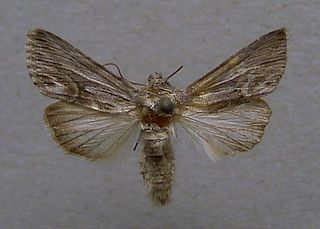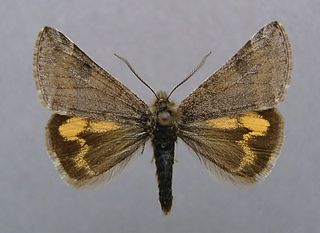
The palmate newt is a species of newt found in Western Europe, from Great Britain to the northern Iberian peninsula. It is 5–9.5 cm (2.0–3.7 in) long and olive or brown with some dark spots. The underside is yellow to orange, and the throat, unlike in the similar smooth newt, always unspotted. A dark stripe runs along the head and through the eyes. Breeding males develop a distinct filament on the end of their tail, strongly webbed hind feet, and a low, smooth crest on their back.

Papilio demodocus, the citrus swallowtail or Christmas butterfly, is a swallowtail butterfly which commonly occurs over the entirety of sub-Saharan Africa, including Madagascar, besides the southern Arabian Peninsula. The caterpillars feed on various native plants of especially the family Rutaceae, but have also taken to the leaves of cultivated citrus trees.

Globia sparganii, or Webb's wainscot, is a moth of the family Noctuidae. The species was first described by Eugenius Johann Christoph Esper in 1790. It is found in Europe, Central Asia, from southern Siberia to Manchuria, Korea, Turkey, Syria and Iran.

Minucia lunaris, the lunar double-stripe or brown underwing, is a species of moth in the family Erebidae. The species was first described by Michael Denis and Ignaz Schiffermüller in 1775 and is found in Asia, Europe and North Africa.

Dicallomera fascelina, the dark tussock, is a moth in the family Erebidae. The species was first described by Carl Linnaeus in his 1758 10th edition of Systema Naturae. It is found in most of Europe, through the Palearctic to Central Asia to Korea.
Lachana is a genus of moths in the subfamily Lymantriinae. The genus was described by Frederic Moore in 1888. It contains species native to alpine areas on high mountains in the south of the Central Asia. The females do not have wings and lay their eggs within their own old cocoons.

Cymbalophora pudica, the discrete chaperon, is a moth of the family Erebidae. The species was first described by Eugenius Johann Christoph Esper in 1784.

Colias erate, the eastern pale clouded yellow, is a butterfly in the family Pieridae. It is found from south-eastern Europe, through Turkey over central Asia up to Japan and Taiwan. To the south, its range stretches to Somalia and Ethiopia. The species was first described by Eugenius Johann Christoph Esper in 1805.

Chazara briseis, the hermit, is a butterfly species belonging to the family Nymphalidae. It can be found in North Africa, southern Europe, Asia Minor, the Caucasus, Kazakhstan, Central Asia through Afghanistan, and north-western China and Tuva. It is found on steppe and in other dry grassy places between 500 and 2,500 meters.

Diachrysia chryson, the scarce burnished brass, is a moth of the family Noctuidae. The species was first described by Eugen Johann Christoph Esper in 1789. It is found in central and southern Europe, Asia Minor across the Palearctic to Japan.

Globia algae, the rush wainscot, is a moth of the family Noctuidae. The species was first described by Eugenius Johann Christoph Esper in 1789. It is found in central and southern Europe, Turkey, Armenia, northern Caucasus, south-west Siberia.

Calophasia platyptera, the antirrhinum brocade, is a moth of the family Noctuidae. The species was first described by Eugenius Johann Christoph Esper in 1788. It is found in Europe, the Near East, the western Sahara, Morocco, Algeria and Tunisia.
Lachana selenophora is a species of moth of the subfamily Lymantriinae. It is found in alpine habitats on the high mountains in Central Asia.
Lachana sincera is a species of moth of the subfamily Lymantriinae. A single example was found in 1909 at high elevations in the Wakhan range of the Pamir Mountains of Tajikistan and is only known to have seen again since in 1961. This was also in the area, making it provisionally endemic to southern Gorno-Badakhshan.
Dicallomera pumila is a little seen species of moth of the family Erebidae found in mountains in Kazakhstan and in the southern Urals.

Polyommatus admetus, the anomalous blue, is a butterfly of the family Lycaenidae. It was described by Eugenius Johann Christoph Esper in 1783. It is found in south-eastern Europe and Turkey.

Eucrostes indigenata is a moth of the family Geometridae first described by Charles Joseph Devillers in 1789. It is found in the Mediterranean region, inland up to North Macedonia and Hungary. Subspecies lanjeronica is found in southern Spain and Algeria.

Boudinotiana puella, the pale orange underwing, is a moth of the family Geometridae. The species was first described by Eugen Johann Christoph Esper in 1787. It is found in isolated populations in central Europe, ranging to southern Russia in the east.

Leptogorgia sarmentosa is a species of colonial soft coral, a sea fan in the family Gorgoniidae. It is native to the eastern Atlantic Ocean and the western Mediterranean Sea, with a single find in the eastern Mediterranean.
Gynaephora rossii, in English known as Ross' tussock moth, is a species of tussock moth in the family Erebidae. It is widespread in the tundras and highlands of the Holarctic. It has large, furry caterpillars which seem to eat mostly saxifrages.


















